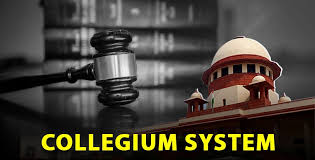Collegium System in India
- ByAdmin --
- 16 Jul 2024 --
- 0 Comments
COLLEGIUMS SYSTEM IN INDIA
A new system has been created to guarantee a democratic process for appointing and transferring judges. The term Collegium is not found in the Constitution; rather, its implementation comes from judicial decisions.
The Chief Justice of India leads the Collegium, which includes the courts four other most senior judges. High Court (HC) Collegium: The Chief Justice (CJ) and four other most senior judges of that court lead an HC Collegium.
Evolution of Collegium System
The Collegium system developed through extensive judicial rulings. The CJI leads it and includes the court's next four most senior judges. The second and third judges' case judgments signify the evolution of pronouncements.
In the First Judges Case of 1981 (S P Gupta Vs Union of India)[1], a seven-judge Constitution Bench ruled that the President of India has the ultimate authority to make appointments and is not bound to heed the advice of the consulted judges. The ruling clarified that 'consultation does not imply concurrence'.
In 1993, the Supreme Court Advocates-on-Record Association Vs Union of India,[2] known as the Second Judges Case, saw a nine-judge Constitution Bench overturn the ruling in the SP Gupta Case. They established the 'Collegium System', a distinct process for appointing and transferring judges in the higher judiciary.
In matters of appointment and transfer, the Chief Justice of India (CJI) was given utmost importance, with clarification that the term 'consultation' would not diminish the CJI's primary role in judicial appointments. The CJI's primary role is deemed crucial because, being within the judicial domain, the executive branch cannot have an equal influence.
The Third Judges Case in 1998 reaffirmed the 1993 decision with slight modifications after the President referred the matter under Article 143 of the Constitution. According to the 1998 opinion, the recommendation for appointments etc. should be made by the Chief Justice of India and his four most senior colleagues, rather than the previously required two. This group is known as the Collegium.
The 1993 ruling and the 1998 statement both affirmed that the Chief Justice of India should be appointed from the most senior judge of the Supreme Court.
In 2014, Ravi Shankar Prasad, who was the Minister of Law and Justice at the time, presented the National Judicial Appointments Commission Bill, which was later passed by Parliament. This bill aimed to replace the existing Collegium System with the NJAC and proposed the addition of Article 124A to the Constitution. Criticisms of vagueness and lack of transparency led to the decision to replace the Collegium System, resulting in the establishment of the NJAC through the 99th Constitutional Amendment Act in 2014.
Fourth Judges Case (2015)[3]:In 2015, the Supreme Court was presented with a challenge to the constitutional validity of the Ninety-Ninth Constitutional Amendment and the NJAC Act, 2014.A majority of 4:1 in a constitutional bench of five judges declared the NJAC unconstitutional and void, citing its potential threat to the independence of the judiciary.
In a recent ruling, Advocates Association Bengaluru vs. Barun Mitra[4], the Supreme Court emphasized to the Central Government the importance of adhering to the Collegium system as it is the established "law of the land". The Court emphasized that despite differing opinions from certain segments of society, the Collegium system remains the established law of the land. (CONMT.PET. (C) No. 867/2021 in T.P. (C) No. 2419/2019; 08-12-2022)
Conclusion: The Collegium system ensures that the judiciary remains free from political influence, separating it from the executive and legislative branches and guaranteeing a fair process for judicial appointments.
[1] AIR1982 SC 149
[2] AIR 1994 SC 268
[3] (2016) 5 SCC 1
[4] CONMT.PET.(C) No. 867/2021 in T.P.(C) No. 2419/2019
































































































































































































































































































































































































































0 comments